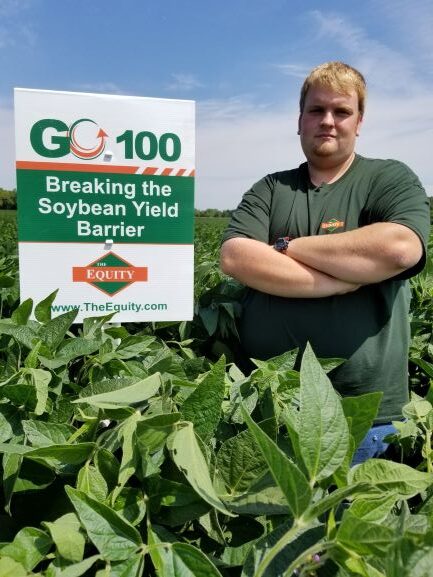If you have ever seen the movie Groundhog Day, you may be able to relate to the main character’s constant dilemma, which is being stuck in the same day, day-after- day. This is how my life, as well as all fellow agronomists and growers, can be feeling this time of year. However, with hard work and persistence comes great reward, which we will glean shortly in the rapidly approaching harvest season.
This coming harvest season brings an extra degree of suspense. For me, I will be harvesting my first Illinois Soybean Yield Challenge contest field. Growing this field of soybeans has been somewhat of an emotional experience, and I think that anyone else who has participated in a similar high-management program would agree. Between countless hours of studying management practices and varieties, to daily scouting trips, my yield challenge field has somewhat taken over my life—in a good way.
I encourage almost all my growers to put out some type of high-management soybean trial on their farm every year. Whether it’s a contest field or a side-by-side trial, the data and results from these on-farm trials generate valuable and reliable data, and even better, it’s from right in your backyard.
Below are 3 simple tips that I would give to you if considering a high management plot/challenge field for 2019.
1. Establish a strong network of industry professionals.
From my experiences in the agricultural industry, there is nothing quite as valuable as a strong network of professionals. When I first started putting my plan to paper, I struggled to come up with a management program that I was confident in. I needed some checks and balances. I am fortunate enough to work in ag retail, which gives me access to multiple industry professionals, many of whom have more experience than me. If you don’t already have one, start establishing a relationship with your local retailer, or a Certified Crop Advisor (CCA). These people are a wealth of knowledge and are just as driven to achieve the highest yields possible.
2. Allocate time for studying and planning.
Planning a high management plot takes a considerable amount of time and thought. Its safe to say that most growers are not growing contest fields for a living, and that finding time to plan can be a struggle. I made myself a goal to read at least 4 different articles on soybean production/management per week. This goal helped me stay immersed in a frame of mind that helped me focus on my plot.
One resource that I found extremely helpful was www.ILSoyAdvisor.com. ILSoyAdvisor not only posts frequent articles that are up-to-date with current soybean management topics, but the best part about this resource is that it’s all about the bean! I found it hard to find another resource that was completely dedicated to soybean agronomics, and on top of that features industry leading experts and perspectives. The articles from ILSoyAdvisor really helped guide me throughout the growing season.
3. Don’t be afraid to raise the bar.
When entering a contest field in the Illinois Soybean 100-Bushel Yield Challenge, or any other contest, it’s safe to say that you are probably going to have to do things a little differently than what dad or granddad did in the past. It’s hard breaking away from traditional soybean management practices, especially when you have done it successfully for many years.
I have tried a whole lot of new things in one year. You might even catch a glimpse of our “kitchen sink” somewhere between the rows of my yield challenge plot. However, all my decisions on products used or management practices were not considered without the ultimate end goal of ROI in mind—that’s what it’s all about. Don’t be afraid to try new things on your soybeans. If it adds yield, it can be tested again next year on a broader number of acres, and if it doesn’t show a positive ROI, than you can try it again next year—I always recommend testing and collecting more than one year of data before I exclude any practices.
The time and experiences that I have taken away from growing my first yield challenge plot so far has been valuable to me as a professional in the ag industry. But the one big takeaway that I was not expecting—it has made me a better agronomist. It has helped me better serve my growers and it has helped me keep an open mind in an industry that is ever changing. And although my first yield challenge field is not even across the scales yet, I have a feeling that this is the start of a never-ending hobby.
Do you think you have what it takes to break the soybean yield barrier? 2019 is right around the corner.


